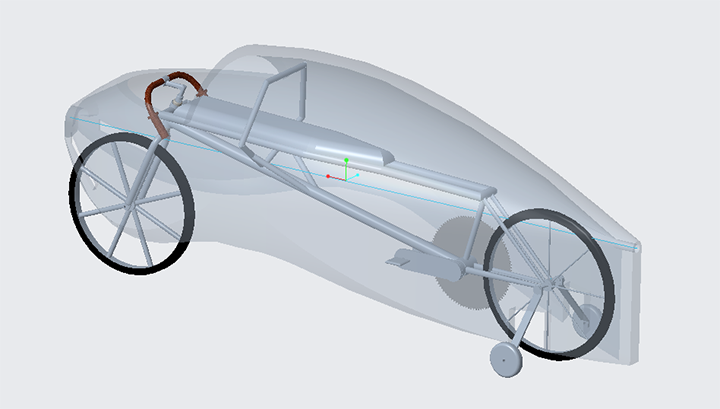Don’t call it a comeback
They’ve been here for years, but this year there’s something different about the Human Powered Vehicle project at Binghamton University. The team is ready to knock out the competition.

The Human Powered Vehicle project has been a staple among the Watson School senior capstone projects for nearly a decade, but this year the team wants to take things to the next level.
Senior mechanical engineering major Anthony Lord is the systems engineer for the team and he has unapologetically announced that the team “wants to break records this year.” Not only do the students hope to break Binghamton University records, but they also have a plan in place to become the fastest Human Powered Vehicle in the sprint challenge at the competition.
“We’ve come a long way,” said Lord. “A few years ago, the fairing for the bike was cardboard. Even last year the seat was made from pool noodles. But this year we’re looking to be more competitive so we’ve started from scratch.”
Lord is joined by senior mechanical engineers Joseph Anderson, Godfrey Fenton, Samuel Lamont, Molly Stenard and Edgar Sarmiento. Their faculty advisor for the project is Assistant Professor Xin Yong from the Mechanical Engineering Department.
“We did a lot of research on the teams that won previously,” said Lord. “A lot of them use carbon fiber because it’s so light but it’s also expensive and difficult to repair when broken.”
The team wanted to make sure its vehicle was durable as the concept for the Human Powered Vehicle Challenge is to create dependable transportation for underdeveloped or inaccessible parts of the world.
The Challenge is put on by the American Society of Mechanical Engineers (ASME) with 2019 competitions in India, California, Michigan and Peru. The Binghamton University team will be competing in Michigan and Lord explained that the competition requires that the team not just build its own car, but also race it.
“We’ve been in the gym a lot lately because we are the ones who pedal the vehicle,” explained Lord. “We’re going to do some test runs to figure out who would be the best driver at each point in the competition.”
Aside from the initial design competition, once they are at the race-track there’s a women’s and men’s sprint and an endurance section. It varies every year but sometimes there can even be a night race added into the mix that the teams have to prepare for, regardless of what ends up being slated for the competition.
“We’re really aiming to do well in the sprint. I’m hoping we can top out at 60 mph,” said Lord.
The endurance race can also be a bit of a surprise. Each year, different elements are added. For this year’s challenge, the team has to drag a weighted trailer for part of the course as well as pick up and deliver a parcel. Lord said that some other options require the vehicle to drive over speed bumps or follow a direction change at the last minute.
The competition is in April, so for now, the team will continue building and training but it could also use some outside support.
This year the car is sponsored by AVANGRID, WesLor, Empire Plastics and DRG Machine, LLC. The team is looking for more students (including non-seniors), alumni or community members who want to participate as teammates, mentors or sponsors. Contact Anthony Lord if you’re interested in helping the team.
“We’re trying to beat teams that have giant budgets and a history of doing well at this competition,” said Lord. “We want to put Binghamton’s Human Powered Vehicle on the map this year.”

